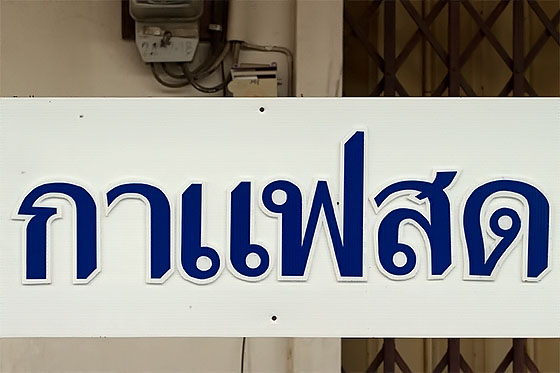Learn How To Read Thai - Tutorial 4
The Snake Consonant
Let's slow down again and just add one more consonant today. As with all the consonants and vowels covered so far, this is another very common one so it is well worth remembering. By adding this consonant to the characters we have already learnt, we have enough letters for another Thai place name.
A word of caution, though. Beware that this is a consonant that can cause a few pronunciation problems for foreign speakers of Thai.
ง
Name in Thai: ง งู
Name in English: Ngor Ngoo (snake)
Initial: ng
Final: ng
Class: Low
Usage: Very common
Writing practice: Download Worksheet
Comments: The consonant cluster 'ng' is very common in English at the end of words but this sound is also used in Thai at the beginning of words. Most foreign speakers (myself very much included) have problems with the pronunciation when words begin with 'ng'. Some advice I read was to say 'singing' and then try to drop the 'si' so you just say 'nging'.
Reading Practice
Here's the next place name.

ตรัง
You should be able to read this from the information I have provided so far. A possible stumbling block is the unusual font, which looks like nothing like the font I have been using in these tutorials.
First is the consonant that is halfway between a 'd' and a 't'. It is followed by an 'r'. These two consonants form the consonant cluster 'dtr'.
Above the second consonant in the consonant cluster is mai-hun-aagaat (short 'uh' sound) and the final consonant is the one we covered today 'ng'. As 'ng' comes at the end of this word it is easy to pronounce.
This is a place name that is commonly transliterated as Trang but, once again, if you say 'Trang' to a Thai you will get a blank look. The 't' isn't fully aspirated but has a bit of a 'd' sound as well.
The 'r' is quite rolled - like a Scottish 'r' - and the 'a' isn't an 'a' at all but a short 'uh'. A better transliteration would be 'Dtrung'. If you pronounce 'Trang' with a southern United States drawl or an Australian rising inflection it then becomes even more difficult for Thais to understand what you mean.
What about tone? Once again (keeping things nice and simple), there is no tone mark used with this word. This is actually a live syllable. Syllables ending with a long vowel, or the short vowels 'ai' and 'ao', or an 'm', 'n' or 'ng' sound are live.
The class of the initial consonant is mid, therefore, the tone is mid (see the table below).
Review
One of the things I don't like about books that teach foreigners Thai is that almost straight away they throw 44 consonants and 32 vowels at the new learner. It seems like a mountain to climb. Many people think it is too much and give up before they have even started.
What the books don't explain is that quite a few consonants are so rarely used that even Thais forget how to write them. Some consonants are used all the time and if you learn these first you will be able to read lots of words quickly. That's why I have indicated usage with each consonant.
So far, I have covered just six consonants and two vowels but already we have been able to make two place names from these characters. The characters covered so far are easy and very commonly used, thus they are worth remembering.
The vowels get tougher later, and there are some rarely used consonants to cover but I will tell you if they are rarely used.
Don't worry too much about the tone rules at the moment but concentrate on remembering what the characters look and sound like. I am covering tone rules for the sake of completeness but these can be learnt later.
With the characters we have covered already, we can make another word. You should be able to read this very easily. If not, you need to go back and study more!
กระบะ
Transliterated into English, this word sounds something like gruh-buh. Both syllables are short, and the standard (confusing and inaccurate) transliteration system would probably turn this into kraba.
Both syllables are dead with a short vowel. The initial consonants of both syllables are mid class so the tone is the same for both syllables - low tone.
It's the Thai word for the type of vehicle that most people know as a pickup truck, except in Australia where it is known as a 'ute'. When a drunk driver knocks you off your motorbike (or kills you) on one of Thailand's notoriously dangerous roads, he will most likely be driving one of these. This is therefore a good word to know when you are filling out the police accident report.
This brings me on to an important point for new learners of Thai.
After studying from books, once you start to get out into the real world you will notice that the Thai fonts used on signs look nothing like the fonts in your books. You then have to start learning again and at this stage it is best to ask Thais.
It took me a while to realise that what looks like an English 'S' is ror reua and what looks like a backward 'C' is wor wairn. This can't be helped and it is just something you need to be aware of.
Look again at the word above and now look at a real sign that uses this word. You will see what I mean. The loops in the characters have disappeared and the font used in the sign doesn't look at all like the font used above.

A new Ford pickup truck
Expectations
How long should it take for someone to learn to read basic Thai? This is an impossible question to answer because there are so many variables. It has very little to do with any kind of language ability. Much more important than ability are effort, determination and persistence.
It makes a huge difference if living in Thailand because you are constantly surrounded with practice material and there are lots of people to help you (Thais love to teach foreigners about their language). Anyone who has been living in Thailand for over a year should be able to read basic Thai.
A young German girl I met who is an exchange student was speaking and reading Thai quite well after four months. However, she is completely immersed. The family she lives with only speak Thai, as do all her friends at school. This is the best way to learn.
If you are trying to learn while living outside of Thailand it is difficult. You only see Thai in books, help is difficult to find (unless you are married to a Thai), and learning resources are difficult to obtain. If you are living in Thailand it is really easy. Anyone living in Thailand with a genuine interest in Thailand should not find learning to read basic Thai difficult at all.
Questions And Feedback
If you have any comments, questions or suggestions, feel free to contact me. Your feedback will help me to improve these pages.
Recommended Books
Amazon UK
Amazon UK
Amazon US
Amazon US

